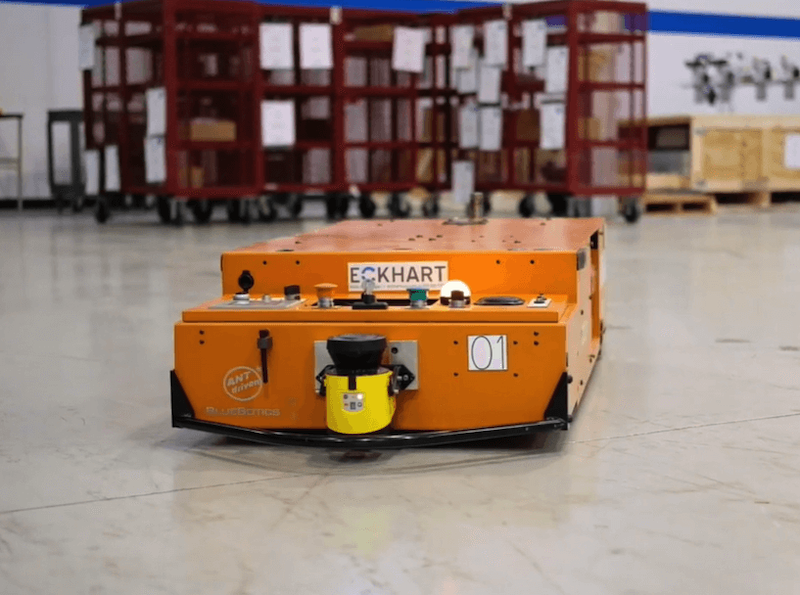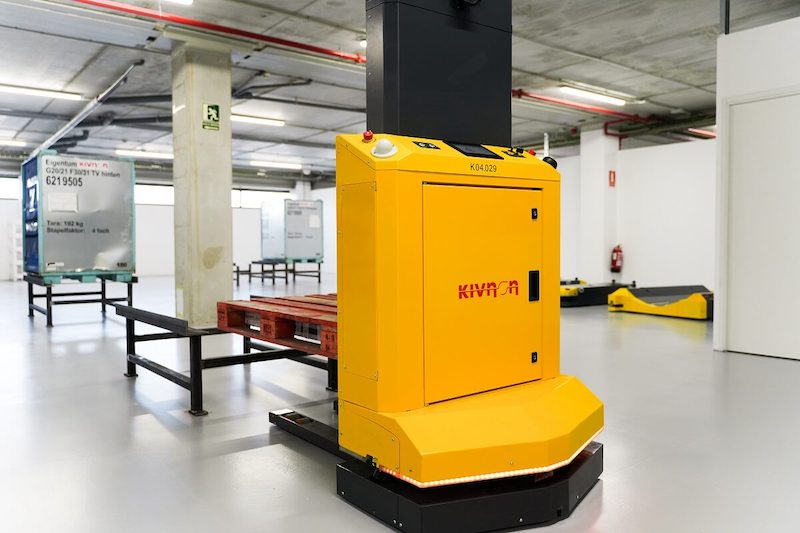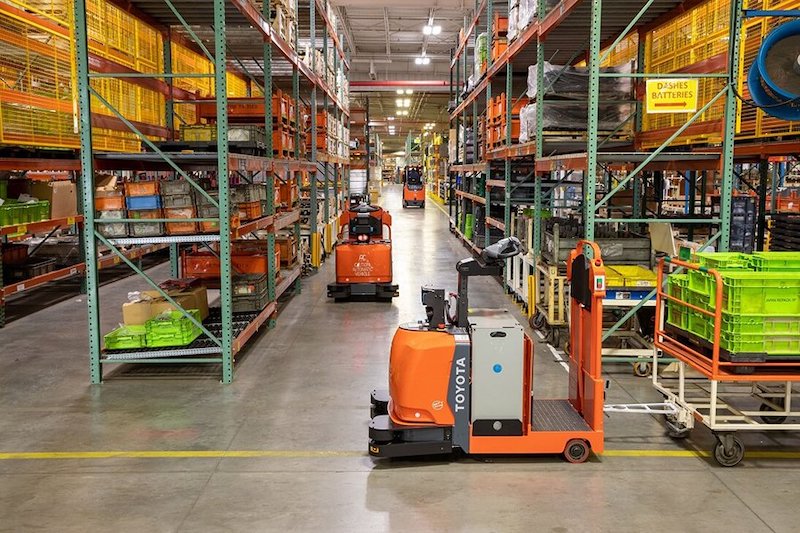Article contributed by BlueBotics
A roundtable discussion with three industry experts’ answers some of the pertinent questions about investing in automated guided vehicles (AGVs) and autonomous mobile robots (AMRs)
The market and interest in Automated Guided Vehicles (AGVs) and Automated Mobile Robots (AMRs) are growing rapidly. These smart machines offer ways to increase production or warehouse efficiency, increase safety, and enhance productivity.
However, if you are thinking of investing, where do you start and what points do you need to consider?
This article aims to offer some tips, advice and insights from these leading industry experts:
- Michael Marcum: General Manager – Autonomous Vehicles at Bastian Solutions;
- Jeff Chu, Director: Future Factory Services at Eckhart; and
- Thierry Delmas: Managing Director at Kivnon.
The experts answer some of the key questions to get you started on your AGV/AMR journey.
Key applications
Although warehouses and material logistics within a manufacturing setting are currently the core applications for today’s AGVs and AMRs, their usage continues to expand.
Delmas of Kivnon says, “Our mobile robotics solutions automate different applications within the automotive, food and beverage, logistics and warehousing, manufacturing, and aeronautics industries.
“The tasks and processes which benefit from automation with AGVs/AMRs are continuously expanding. From indoor applications where space is tight to more and more outdoor applications, technological advancements are enabling more possibilities than ever.”
“Most of our customer applications fall into two categories within manufacturing applications,” comments Marcum of Bastian Solutions. “The first is assembly lines, with the AGV serving as an indexing line interlocked to their MES (manufacturing execution system) for “no fault forward” of the product. The second most utilized application is for material delivery to production lines or shipping areas.”
Chu of Eckhart adds, “We see AGVs deployed in a diverse range of industries including electric vehicles, aerospace, renewable energy, defense, automotive, and heavy industrial.
“Many customers utilize AGVs for assembly line conveyance. Here AGVs are increasingly the solution of choice in heavy-weight applications (products exceeding 10,000 lbs.) compared to the traditional ‘chain-in-the-floor’ tow line.”
Automation drivers
AGVs and AMRs offer significant benefits across a wide range of applications and multiple industries. They are flexible, configurable, require less space than many other material logistics solutions, and enhance the safety and welfare of personnel.
“More and more manufacturers, research firms, and companies are turning to automation to reduce costs and boost quality. Investing in new technology helps them compete and win new opportunities in different industries,” says Delmas.
This is confirmed by Chu, who adds, “The motivation for utilizing AGVs as the method for assembly line conveyance is driven by multiple factors, but primarily value is realized through enhanced flexibility and improved safety and ergonomics.
“For example, a traditional towline has a fixed path, and each station is coupled to the previous one. AGVs, on the other hand, can be easily programmed to take a new route depending on the process needs.
“They can handle divergent material flows and branch off to new paths depending on production needs, giving complete flexibility and greater agility to adapt to changing requirements.
“The use of AGVs also means workstations can be decoupled and buffer stations used to increase production efficiency, reduce bottlenecks, and smooth over intra-station variability during the production process.”
Delmas continues, “AGVs and AMRs help if business continuously has production issues, or the production methods fail to meet customer demands. They reduce reliance on manual labor availability and free workers to carry out more value-add tasks for the business, especially where goods are transported over long distances.”
“Customers have told us that improved quality and cost reduction are some of the key objectives they target with their automation strategies. Improved quality comes from careful load handling, precise navigational methods and reliable safety ratings,” comments Marcum. “Cost reduction derives from improved quality, but also from continuous operation capabilities and ability to scale alongside business needs.”
Chu concludes, “The safety offered by AGVs is also a key factor. The sensing and navigation technology on these machines means they can detect interferences in the path and programmatically stop before any contact occurs, significantly reducing the risk of collisions.”
What to automate first
The impact a mobile robotics solution can have on a business will depend on the specific application and business goals, but there are some common areas where the return on investment is the highest.
“Areas that do not necessitate complex transformation but will improve existing processes and employee availability are obvious areas to start. The longer the distance, the more you can contribute to improving work times, worker well-being, and safety. It is better to use people when you want to bring value to the process and better to use AGVs when you don’t,” advises Delmas.
“AGVs are great candidates for automating processes that are inherently dangerous or don’t add value,” adds Chu. “These could be tasks where operators have to manually heavy loads, or heavily-utilized fork-truck routes, which are often the source of near-misses or accidents.”
Assessing the impact
Chu says, “AGVs can improve both top and bottom-line metrics and can ultimately lead to more predictable outputs that can be scaled up over time. They can save time and deliver safety/ergonomic improvements. When it comes to safety, although getting to zero incidents is a universal goal, the time savings from incident reporting or boosts to morale from having a safer environment should also be factored in.”
“If workforce efficiency and safety are the top criteria for deploying AGVs, the impact will be visible,” adds Delmas. “It could be increased working hours, worker availability, or successfully elimination of accidents and fatalities. The AGVs can operate in shifts around the clock without compromising safety or quality of work. ROI can be attained in less than a year.”
Optimizing for success
A successful automated vehicle project requires careful planning and should be carried out in partnership with a company that has deep experience and a long track record in such applications.
Delmas advises, “Plan for success by choosing an integrator who is well-versed in evaluating needs, processes, and benefits. It is easy to complicate and endanger the effectiveness of the project by overdoing things. An expert, measured approach guides the investor through each step and is the best way to ensure long-term success.”
Marcum also recommends that companies should, “Start small and create standards so that you can scale up over time by leveraging what you learn. It’s also important to choose a supplier who can support your operations with service, parts and support for years to come.”
Chu adds that adapting tasks in advance can help optimize for the success of an AGV or AMR project. “Often companies can make small changes, whether to layout, schedule, or process design, that greatly help standardize, and enable automation,” adds Chu.
Common mistakes
Mobile automation presents a new paradigm for material flows and should not be approached with reliance on “the way things are always done”. This is confirmed by Chu, who says, “Manufacturers should think about what is possible, instead of replicating how things are historically done.”
Companies should also prepare carefully, says Delmas: “A common mistake is estimating the requirements and the impact of the project incorrectly. Although there may be more pressing issues you want to address at the start, an integrator will study many factors before offering a solution, analyzing, simplifying, and standardizing the process.
“Don’t try to use too many different vehicles, featuring different navigation technologies, as this will make the facility overly complex and challenging,” adds Marcum. “For a fail-safe approach, I advise to start small with simple tasks and expand from there.”
Ensuring staff acceptance
When adopting mobile robotics, it is important to manage the arrival of these technologies carefully to avoid potential resentment by existing teams. Here, automating unloved tasks, with plenty of supporting communication, is recommended.
“As a first step, automate processes that no one wants to do. This helps employees see automation as a benefit to them,” states Marcum. “If roles need to be repurposed, have a plan communicated before AGV implementation. This creates open lines of communication with operators to get feedback on workflows, which leads to better utilization of the automation and higher acceptance.”
“Explain that AGVs and AMRs will help employees carry out more strategic work instead of heavy lifting,” Delmas adds. “Explain they will be able to use robots more like assistants to perform manual tasks and that they will help eliminate accidents that endanger their livelihood and future employment. Instead of fear of losing a job, it should be about the opportunities it opens.”
Chu supports this benefits-first positioning: “Automation is not meant to take away someone’s job, but to improve the overall work-place environment by creating a safer and more ergonomic working environment.”
Simple steps
Automated vehicles are quickly becoming a stalwart of manufacturing sites and warehouses. In many applications they are more accurate, safer, and more efficient than manual processes and support the workforce in carrying out mundane tasks.
By taking simple steps, understanding what you are trying to achieve, choosing the right automation partner, and taking the workforce on your automation journey with you, these machines offer many benefits and can significantly increase operational productivity.













